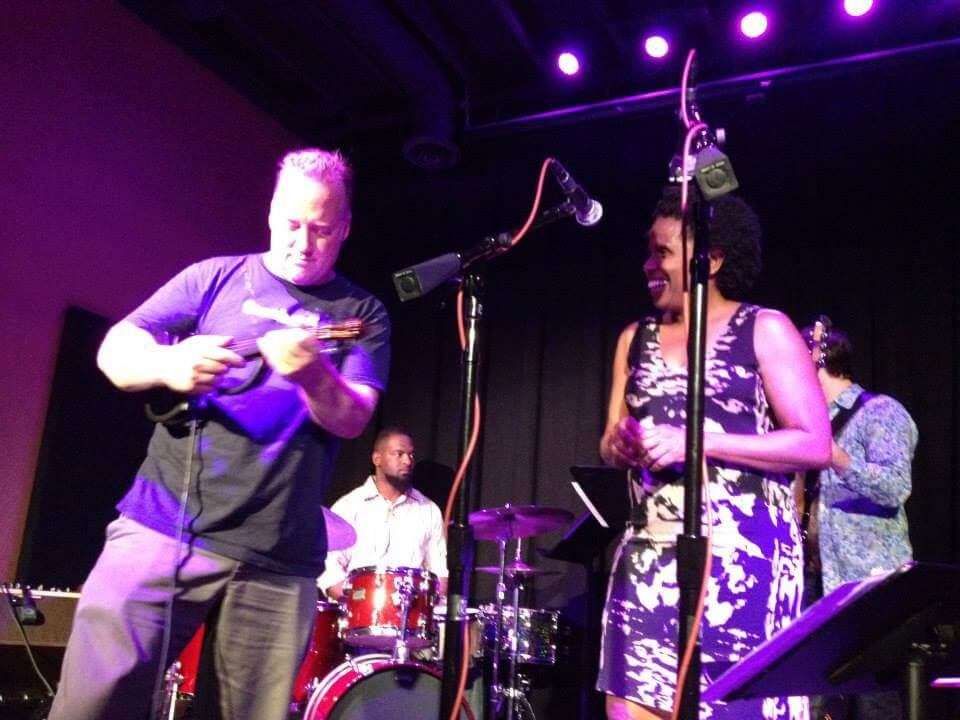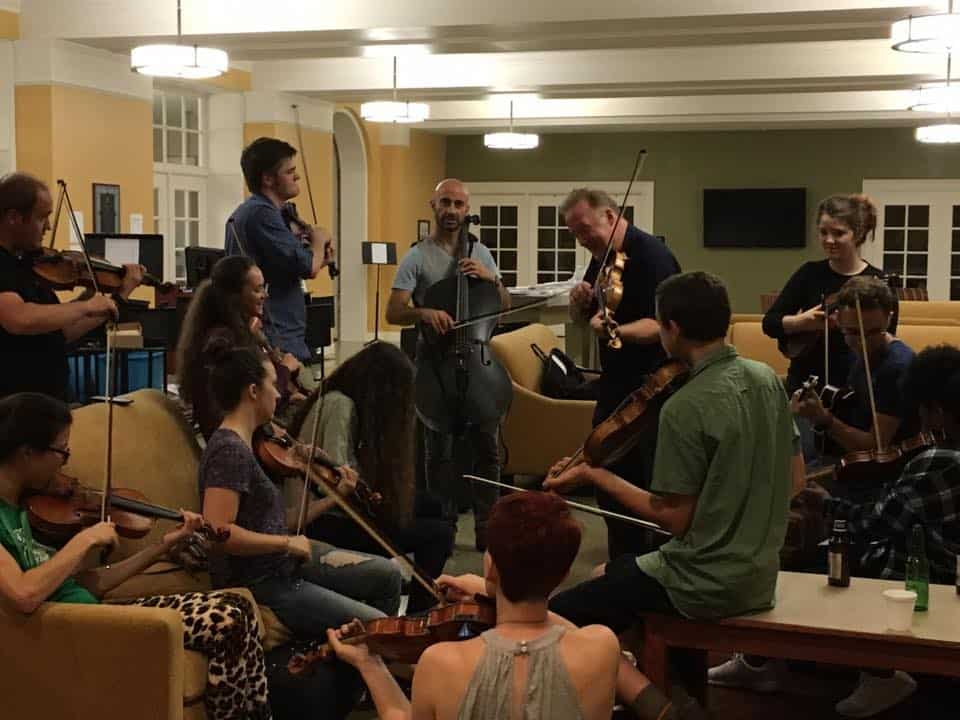Collaborating in new musical settings is a great way to grow your skills. It can also be scary.
So, how can you make collaborations succeed in unfamiliar or new musical situations?
To help with this, I put together an 11-point checklist (plus some guidelines for how to make a good impression).
Watch/listen or read below to discover:




Subscribe to get all episodes by clicking the icons below



Thanks to Electric Violin Shop and Yamaha for supporting the Creative Strings Podcast.
First, I want to dispel the popular misconception that improvising is always about doing “whatever you want”. There are times and places for doing what you want, but you generally want to be mindful of other musicians. The first rule is to do no harm.
Every collaboration benefits from fundamentals of listening and a balance of give and take. The inclusion of improvisation doesn’t change the parameters of musicality.
As counterintuitive as it may seem, placing restraints upon yourself is often a helpful way to promote greater creativity.
Your role in a band can involve soloing, but it also may require you to think like an arranger and accompanist. Your parts can range from textural colors to rhythmic accentuations to harmony pads.
The 11-point checklist below can help you hone in on composing your part in the band.
There are interpersonal considerations that are just as important to playing with a band on stage or recording in studio.
Without these strategies, when a musician gets asked to sit in with a band, they may freeze up or bull doze ahead with reckless abandon.
I know all about this.
I was mocked, discounted, laughed at…
I was told to “do a two-step and hit a cowbell” (not even allowed to play violin!).
Made to sit through jam sessions for hours without ever being invited up.
Faces made on the bandstand at me.
Threatened
Cursed out
I didn’t know what I didn’t know.
You won’t either. And beginning with this humble realization will save you stress, misunderstandings, and frustration. Because when you come from a place of humility, you’ll act differently around other musicians. It will make all the difference in gaining their respect and finding your lane.

I made the mistake of assuming that since I was an expert classical musician, I was an expert all-around musician. Therefore I sometimes came across as arrogant or condescending when working with musicians in other traditions.
The proper attitude to show is one of respect. And that doesn’t mean showing up like a walking apology.
When we show respect to other musicians, by acknowledging that we don’t know what we don’t know (about the music that they are experts at), we attract respect and appreciation, and foster a healthy collaboration. By making it easy for musicians to ask us for what they want, everyone wins.
When we are insecure and we try to impress people to overcompensate, we may pretend we know more than we do about the music, play too much, or fail to notice or ask how the other musicians are reacting to what we are doing.
All of this usually backfires.
It’s better to have quiet confidence, and yet be deferential in allowing musicians to ask us for what they want in a particular situation. Musicians will always appreciate you when you give them permission to ask for what they want, or better yet, ask them to tell you what they want!
If I lean over to a side person or bandleader and ask, “is this ok, or would you prefer something else?”, it shows that I respect them and the music. It shows that I know that I’m an outsider coming into their world. It sets me up to be more impressive to them when they hear how quickly I can adapt once given clear instructions; And it makes it easier for them to give me those instructions.
This is universal to any social encounter in which we are new and we join a group of people who are already established in that group.
For example, if I walk into a baby shower for the first time ever, the way to make it a positive experience is for me to basically shut up and listen. Not try to take over the party. I’m a dude who is not used to hanging out at baby showers, and I don’t know how to contribute, so I should listen and ask questions.
If I go to a few baby showers, I could begin to learn how to behave and navigate the situation. I could gain even be considered part of the inner circle. But it requires respect, self awareness, and patience at first.
After a lot of hard knocks I learned to make it work with musicians in all kinds of settings.
Demonstrating social grace is more important than practicing licks, because you’ve got to be able to find a way to get along with other musicians, and to begin to truly appreciate and understand what they do and how they think about music.
Here are some funny examples of situations that were way outside my comfort zone:
-My drummer for a performance in a small town in China showed up with a water jug. That was his drum kit…
-Opening for Journey with a classic rock band at the Kansas State Fair.
-A string quartet collaboration in the recording studio with a hip hop group in Brooklyn.
-Playing a 4-hour stadium concert w/ a band from India without rehearsal or sheet music
-Playing, producing, and arranging on hundred of recording sessions for producers with many different ways of going about the production process
Now you’ll get my checklist to better navigate, anticipate, and avoid conflicts, to optimize success when collaborating with musicians who think differently than your orchestra conductor
First, I’ll give you the musical checklist, i.e., what to do or not do every minute when you’re collaborating with a band.
Then I’ll give you a list of specific interpersonal suggestions, related to my preamble, that are just as important.
Implement these suggestions and you’ll be a hero to the audience and the musicians, and they’ll call you back again and again.
-11 Tips to Playing with a Band for Classical Musicians-
1)Know when to lay out – To lay out is to NOT play. This is literally the most important thing you need to do. Do not play all the time, unless you are asked to do so. It’s far better to have someone asking you to play more than feeling the passive aggressive energy of someone who is trying to find a way to give you a hint to play less.
Of course there are exceptions to this, depending on the scenario. A fiddle player might play 80% of the time in a Bluegrass band, for example.
You may feel uncomfortable laying out. When laying out, you can listen and look around at the band, sway or tap your foot to the music, close your eyes and listen, smile, appear deep in thought, or whatever you want, but I recommend you tune into the music. Over time you should get more comfortable with laying out.
Case in point, in my own jazz quartet (with drums, bass, and piano), I lay out at least 50% of the time.
Some songs may require you to play all the time, but others you may lay out 25%, 50%, or 75% of the time. You may want to think about this before you decide what to play on a particular song w a band. Map it out in advance so you know exactly when you will play or lay out. For example, if I’m working with a singer songwriter or rock band, often I will play on an intro and then lay out on the first verse of a song, entering on the second verse; or waiting to enter until after 2 verses and a chorus have gone by sometimes.
By simply having a clear intention and structure around when to play or lay out, this contributes to the long arc of the song, giving a lift to keep the energy of the song over multiple verses. And it makes people notice and appreciate when you actually play.
2) Master the fills— Short melodic ideas in the rests when the singer is not singing (or melody instrument is not playing melody). There are two common ways to organize fills. Either take a full verse with fills OR alternate phrases within the same verse w other people in the band who are filling such as a lead guitar, keyboard, or even the bassist.
Here are tricks you can try when practicing to make your fills sound more convincing:
Try clapping the rhythm of your fills before adding notes to them. Non-specific rhythm is the death of many an ill-fated fill.
Listen to the words and respond musically based on what they mean to you.
Respond to the melody line of the singer. Play something like, or unlike, the singer’s melody.
Respond to the other fills. Listen to the fills played by other members of the band and do something like or unlike that.
Outline a simple melodic shape using chord tones. (For more see the “Easy Tonal Improvisation” course on this page.)
3) Go for the chord tones, aka, PADS– A PAD is one of the easiest thing to do if you know the harmony or are able to hear the chord tones. The safest way to play a pad is to play voice-led chord tones following the harmonic rhythm (playing on the downbeat of each chord with the keyboard or rhythm guitar and bass).
If you don’t have the voice leading internalized between chord tones from different chords, the easiest way to deal with this is by creating a diagram that I call a Chord Stack. It contains all three notes in the triad stacked everywhere they occur in first position on your instrument. (This is covered in one of my most popular courses in Creative Strings Academy.)
Pads can gradually be embellished to include playing multiple chord tones and/or joining the chord tones with short melodic motions through passing tones. I recommend that if you plan to play double stops on violin, viola, or cello, use caution, and make sure you can hear yourself clearly on stage. If it’s hard to hear yourself in the monitor during a given performance, bail on the double stops and go with single notes.
4) Unison melodic figures-Copy the figure and play in unison- often there will be a “hook” or a melodic figure that other members of the band play. Sometimes it will be a centerpiece, and other times it may be more of an accompaniment figure. If it’s the centerpiece, chances are you can either double the line or harmonize the line. If it’s an accompaniment part played by the guitar or bass you may want to ask whether they would like you to double it (or play it a few times and observe the body language and face of the player you are doubling.)
5) Harmonize the figure- Instead of playing in unison with the melodic figure, play a harmony.
6) Rhythmic textures– This is very context dependent. Never chop unless the drummer stops playing. Let the drummer handle the percussive aspects.
7) Double a vocal melody– Play the same notes that the vocalist sings, however, be cautious with this one. Make sure the vocalist likes it.
8) Harmonize vocal melody- Again, try it, see if the vocalist likes it or not. Be sensitive.
9) Play colors or effects using various extended techniques with or without augmentation of effects pedals. Harmonics, trills, slides. You can augment the effects using pedals like delay, flander, wah wah, distortion etc. You could also combine some of those!
10) Double the guitar, bass or horns when asked to. This only happens on occasion.
11) Take a Solo- Generally check with the bandleader to be clear on when the solo is and how long it should be.
If you are going to play with a band, keep this list handy- chances are, you should be able to find the answers here.
-How to Communicate with Musicians from Different Musical Worlds-
One of the biggest issues you’ll face has to do with translating between the language of a classical musician vs the language other musicians speak.
Don’t expect a bandleader to speak your musical language. They may not hand you sheet music and say, “play detache bowings with a slight rubato in measure 32”…
They’ll make perfect sense to musicians who speak their language. You are the outsider. You can eventually learn their language, but in the meantime, find ways to create understanding and agreement with the right questions, references, and prompts, for example-
Questions to ask your bandmates:
Should I lay out in the first verse?
Can I play two different examples over this section of the song and you tell me which one you prefer?
Would you like me to play high (like this) or low (like this) ?
Would you like me to play dense (like this) or sparse (like this)? When you say “like this”, demonstrate your ideas.
Make it easy for them to say “yes” or “no”.
Do they like this or that? Do they want you to lay out or not in a specific section?
They can tell you “I like that one”. Or they can say “Yes”.
That’s what understanding each other looks like, when everyone is on the same page.
The more you can discern what your musicians are looking for from you, the more you will be a hero.
Give them permission to tell you what they want.
Watch for visual cues from the band.
Ask if they want anything different.
Prompt their feedback by saying things like, “How do you like the part I came up with for the bridge? Is it too busy? Would you like to hear it played down the register? “Is the chopping pattern I’m playing working or should I try a different type of groove during this section? Can you play for me an example of something you’d like to hear?
So, or any situation, if you keep the checklist above handy, and if you follow the guidelines around communication, you will learn faster, build positive relationships, and gain confidence.

Now… if you want to try all this out in a musical environment where you’ll be encouraged instead of laughed at, taught instead of criticized, and helped instead of hurt…
If you want to have the time of your life connecting with musicians from around the world,
If you want to rub shoulders with the very best teachers, and…
If you want to surprise everyone you know by killing it when you finish,
Then buy a ticket to the Creative Strings Workshop, (online or in-person).

_____________________________________________________________________
Table of Contents
Thanks to our sponsors Yamaha and Electric Violin Shop.
Subscribe to get all episodes by clicking the icons below



Please take a moment to visit Electric Violin Shop, your one-stop shop for electric instruments, amps, gear, accessories, and most of all, expertise. Use code CHOWES at checkout and take 5% off of your order. Call 866-900-8400 to get your questions answered on “all things electric strings.”
While you are talking to EVS, be sure to ask them about the new Yamaha Electric Violin (you can check out my video review here). I’ve been a Yamaha performing artist for over 20 years and am very proud to be a part of the Yamaha family.






